Southminster Maltings
|
Ale
was considered a very important part of life in the
country until Temperance movement in the later part of
Queen Victoria's Reign. Every village has
several public houses and ale houses and most men brewed
their own ale at home. To cope with the
large volume of brewing small malt houses were common
but there was was a demand for large Maltings. Eastern Essex
produced large amounts of Barley and has an existing
network of Quays allowing Thames barges of taking the
Malt to the main markets in London. This made it a
natural siting of a Malting and about 1845 a Malting
plant was built at Hall Lane, Southminster. THE
PROCESS Barley was stored
in hoppers awaiting process The barley was
sifted remove unwanted husks or other items The Barley was
placed in a large vessel and soaked with water to allow
the grain to swell The grain was
monitored to ensure that it is moist without being
waterlogged The grain was then
drained and allowed to rest before being transferred to
the malting floor The barley was
left untouched to start germination for about a week The barley was
left until it started to sprout The Maltster then
judged when to transfer the barley into the Kiln This judgment was
critical requiring great skill from the Maltster The grain was then
dried and cured to produce malt The length of time
and the heat applied to the kiln determined the type of
malt
SOUTHMINSTER MALTINGS
Southminster Maltings produced large amounts of malt
from about 1845 until it was demolished 1972 to make way
for an industrial estate The Malthouse at
Burnham appears to have closed at about the same time as
by 1871 the census records the address as a disused
Maltings Yard. Likewise the
Southminster malt house that had been run by the
Stebbings family. Water was
important for the process and so several wells were sunk
to tap into underground water. As a benefit to
the community a public pump was installed in hall Road
near to the Maltings to help deal with local water
shortages during dry times The Maltings made
use of the new technique for cast iron in its
construction using iron columns on the ground and first
floor construction although the builders reverted to
wooden columns for the second floor The large volume
of malt is indicated by the provision of five kilns one
of which was conical and the
remainder followed the latest industrial model of being pyramid shaped.
The malt was loaded onto large
carts drawn by horses and taken to Maldon, Chelmsford
and to the local quays
THE MALTSTERS Maltings reflected
two unusual patterns of employment for their era. Firstly Maltsers
often moved large distances between maltings reflecting
the need to ensure skilled men in the key position at
each malting. Secondly there
were not labour intensive as was most occupations,
requiring only a few men to work a large building and
high volume of malt. A snapshot taken from 1871 explains a little about the lives of the many men who worked at the Maltings. In 1871 there were 7 men employed at the Maltings who lived in
cottages on the site.
The Census lists them as
Only George Beale was born in the area wityh the remainder travelling to Maltings that needed their specialist skills.
Samuel Lambard lived with his wife Lucy aged 60 William Lambert
and George Beale were listed as lodgers with Emma Jordan
39 years who is described as widow of Maltster
James Kerridge appears to have
been the expert brought in to run the new Maltings
Census returns for James Kerridge demonstrates life in
the latter part of the 1800's In the 1851 Census
he is listed as a Maltster at Larling, Norfolk In the 1861 Census
he is listed as a Maltster at Coltishall Suffolk In the 1871 Census
he is listed as a Maltster at Southminster Essex In the 1881 Census
he is listed as a Maltster at Southminster Essex In the 1891 Census
he is listed as Parish Clerk/Gardener at Southminster -
He is still at Hall Road but his wife Ann is not listed
although his 18 year old Grand daughter is listed . She
is probably his housekeeper following the death of his
wife Ann
In the 1901 Census he is
listed as Church Clerk/ Gardener. His Grand daughter is
no longer listed but he has a new wife called Susannah
aged 65 |
||||||||||||||||||||||||||||||||



